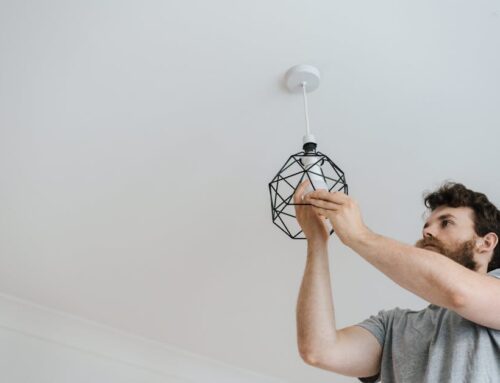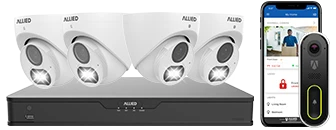Understanding the Basics of Home Alarm Systems
Home alarm systems are designed to provide security and peace of mind by alerting homeowners to potential intrusions or emergencies. Understanding their basic components and functionality is essential for making an informed decision when selecting the right system.
Key Components of Home Alarm Systems:
- Control Panel: The brain of the system, responsible for communicating with all other components and managing system functions.
- Sensors: Devices that detect changes in the environment, such as door/window sensors, motion detectors, and glass break sensors.
- Keypads: Interfaces used to arm and disarm the system, often located near main entry points.
- Alarms: Audible or visual signals that alert occupants and deter intruders.
- Monitoring Service: A professional service that monitors the system and alerts authorities if an alarm is triggered.
How Home Alarm Systems Work:
When a sensor detects an unusual event, such as movement or the opening of a door, it sends a signal to the control panel. The control panel then processes this information and triggers the alarm if necessary. If the system is monitored, the monitoring service is notified and can quickly dispatch emergency responders if needed.
The following table summarizes common sensors and their functions:
| Sensor Type | Function |
|---|---|
| Door/Window Sensor | Detects when doors or windows are opened |
| Motion Detector | Senses movement within a designated area |
| Glass Break Sensor | Detects the sound of breaking glass |
| Smoke/Fire Detector | Alerts to the presence of smoke or fire |
| Carbon Monoxide Detector | Detects dangerous levels of carbon monoxide gas |
It’s important to have a comprehensive understanding of these components and how they interact within the system to ensure the protection of your home. By familiarizing yourself with the basic elements, you can better evaluate your options and choose a system that meets your specific security needs.
Evaluating Your Home Security Needs
Evaluating your home security needs is a critical step in selecting the right home alarm system. Proper evaluation ensures that you invest in a system that provides optimal protection for your specific situation.
Factors to Consider
Here are key factors to consider when evaluating your home security needs:
- Location: The crime rate in your area is a significant factor. Homes in neighborhoods with high crime rates may require more advanced security solutions.
- Home Size and Layout: Larger homes or those with complex layouts might need additional sensors or cameras to cover all entry points effectively.
- Entry Points: Identify all potential entry points, including doors, windows, and garage entries. Ensure that each point can be secured adequately.
- Family Lifestyle: Consider the daily routines and habits of family members. Systems should not impede daily activities but should provide security when needed.
- Valuables: If you have high-value items, such as art or jewelry, you might need a system with enhanced security features like motion detectors and smart locks.
- Pets: Pet-friendly sensors are necessary if you own pets to prevent false alarms caused by their movement.
Risk Assessment
Conducting a thorough risk assessment involves analyzing the vulnerabilities of your home:
- Inspect Potential Weaknesses: Check for areas that could be easily accessible or vulnerable to break-ins.
- Consider Past Incidents: Reflect on any previous security breaches or near-misses to understand specific risks.
- Neighborhood Trends: Stay informed about recent crimes and safety trends in your community.
Security Priorities
Determine your primary security priorities:
- Intrusion Detection: Systems focused on quickly detecting unauthorized entry.
- Fire and CO Detection: Alarms capable of detecting smoke, fire, and carbon monoxide to protect against environmental hazards.
- Surveillance: High-definition cameras for monitoring and recording activity in and around your home.
- Emergency Response: Rapid response mechanisms that alert emergency services during a security threat.
Legal and Insurance Requirements
Some insurance providers offer discounts for homes equipped with alarm systems. Make sure the system you choose meets the requirements of your insurance policy. In addition, familiarize yourself with any local laws or regulations regarding home security systems to ensure compliance.
Aligning your home security needs with the right alarm system is essential in creating a safer living environment for you and your family. A thorough evaluation will lead to an informed decision that yields the best protection for your home.
Types of Home Alarm Systems and Their Features
Home alarm systems come in various forms, each equipped with distinct features to cater to different security requirements. Here’s an in-depth look at the primary types of home alarm systems and their key features:
1. Wired Alarm Systems
Wired alarm systems are traditional security solutions that require physical wires to connect sensors and control panels. They offer high reliability but can be challenging to install due to the need for extensive wiring. Key characteristics of wired alarm systems include:
- Reliability: Less prone to interference, ensuring stable performance.
- Complex Installation: Often involves drilling walls and running cables, which may require professional installation.
- Maintenance: Generally low maintenance once installed, but relocating components can be difficult.
2. Wireless Alarm Systems
Utilizing radio frequency technology, wireless alarm systems connect sensors to control panels without the need for physical wiring. They are increasingly popular due to their flexibility and ease of installation. Features include:
- Easy Installation: DIY-friendly with minimal disruption to the home environment.
- Flexibility: Easier to expand and modify, making them suitable for renters or frequent movers.
- Battery Dependence: Require regular battery changes to maintain functionality.
3. Monitored Alarm Systems
These systems are connected to a professional monitoring service that reacts in case of an emergency. Monitored systems can provide a higher level of security through constant supervision. Key aspects include:
- 24/7 Monitoring: Round-the-clock monitoring ensures that authorities are notified quickly in case of an emergency.
- Service Fees: Often require a monthly subscription to maintain the monitoring service.
- False Alarms: Can result in fees or penalties if too many false alarms occur.
4. Unmonitored Alarm Systems
Unmonitored alarm systems alert homeowners directly via loud sirens, mobile notifications, or both, but do not involve a professional monitoring service. Their features include:
- Cost-Effective: No ongoing monitoring fees make them more affordable over the long term.
- Self-Reliance: Homeowners are solely responsible for responding to alerts, which can be a drawback during vacations or absences.
- Deter Potential Intruders: The noise generated by the alarm may deter criminals from proceeding.
5. Smart Alarm Systems
Smart alarm systems integrate with home automation technologies and can be controlled via smartphones or other connected devices. They offer convenient and advanced features such as:
- Remote Access: Control and monitor the system from anywhere using a mobile app.
- Integration: Can be integrated with other smart home devices like lights, cameras, and thermostats.
- Customization: Offers personalized settings and automation routines to suit individual needs.
By understanding the different types of home alarm systems and their features, homeowners can make informed decisions that best suit their security needs and lifestyles.
Choosing the Right Alarm System Based on Your Budget
When selecting a home alarm system, it is crucial to consider your budget. Understanding that home security is an investment, different systems and their features come at various price points to fit diverse financial plans. Factors such as the complexity of the system, additional gadgets, and subscription fees all contribute to the overall cost.
The first step in aligning your budget with the right alarm system is to differentiate between the initial purchase price and ongoing costs. The initial purchase may include the cost of the control panel, sensors, cameras, and other equipment. Ongoing costs can cover monitoring services and maintenance fees.
The following table outlines common cost components associated with home alarm systems:
| Cost Component | Average Price Range |
|---|---|
| Basic Equipment | $100 – $300 |
| Advanced Equipment Packages | $400 – $1,000+ |
| Professional Installation | $100 – $500 |
| Monthly Monitoring Service | $10 – $60 per month |
There are several cost-effective options available for budget-conscious consumers. These include DIY installation systems, which can significantly reduce your initial expenditure, as hourly rates for professional installers can add up. Some security companies offer packages that can be customized based on your specific needs, allowing you to choose essential features without paying for unnecessary extras.
Another critical consideration is whether to opt for a professionally monitored system or a self-monitored one. While professionally monitored systems provide constant surveillance and immediate response in the event of an emergency, they usually come with higher monthly fees. Self-monitored systems, on the other hand, may incur lower costs but require personal vigilance and quick action during security breaches.
Basic tips for budget-friendly home alarm system selection:
- Prioritize essential features over advanced technology that may not be necessary for your protection level.
- Shop around and compare prices from different vendors.
- Look for bundle deals or discounts, especially during holidays and promotional periods.
- Consider flexible payment plans offered by some security providers to spread the cost over time.
In conclusion, choosing the right home alarm system involves balancing your security needs and financial capacity. By carefully evaluating each component’s costs and comparing service providers, you can find an effective and affordable solution to safeguard your home.
Installation and Maintenance of Home Alarm Systems
Proper installation and regular maintenance are crucial to the effectiveness of a home alarm system. Whether you opt for professional installation or a DIY approach, ensuring that the system is set up correctly can significantly impact its performance.
Professional Installation
Many home alarm system providers offer professional installation services. This option typically involves a trained technician who installs the system according to best practices and ensures all components are functioning properly. Advantages of professional installation include:
- Expertise in optimal sensor placement
- Assurance that all elements are correctly integrated
- Time efficiency
- Technical support during and after installation
However, the downside includes additional costs for the service and potential inconvenience during the installation process.
DIY Installation
Do-it-yourself installation can be a cost-effective alternative to professional services. Many modern alarm systems are designed for easy self-installation, offering detailed instructions and customer support. Benefits of DIY installation include:
- Lower costs
- Flexibility to install at your own pace
- Greater control over the process
However, challenges such as potential setup errors, lack of technical troubleshooting knowledge, and the time commitment required should be considered.
Regular Maintenance
Regardless of the installation method chosen, regular maintenance of the home alarm system is essential to ensure continuous protection. Key maintenance practices include:
- Testing the system: Regularly test all sensors and alarms to verify they are operational. Most systems have a test mode to facilitate this process.
- Updating software: Ensure the system’s firmware and software are up-to-date, as updates often include important security patches and new features.
- Checking batteries: Periodically check and replace batteries in wireless sensors and control panels to avoid unexpected power failures.
- Inspecting components: Perform visual inspections to check for any physical damage to sensors, cameras, and other hardware components.
Regular maintenance not only ensures the reliability of your system but can also prolong its lifespan and effectiveness in safeguarding your home.
Conclusion
Whether installed professionally or by yourself, a well-installed and regularly maintained home alarm system can provide robust protection against potential security threats. Regular testing, timely updates, and periodic inspections will help you retain the reliability and effectiveness of your security investment.
Review of Top Home Alarm System Providers
When selecting the right home alarm system, it is essential to consider the most reputable providers. Below is a review of some of the top home alarm system providers based on factors such as reliability, features, customer service, and pricing.
ADT
ADT is a well-established provider known for its extensive experience in the home security industry. They offer a range of home alarm systems with features including 24/7 monitoring, smart home integration, and mobile app control. ADT also provides professional installation services. While ADT’s pricing can be higher compared to some competitors, their robust infrastructure and comprehensive service make them a reliable choice for many homeowners.
Vivint
Vivint is another major player in the home security market, known for its advanced technology and smart home compatibility. Vivint offers features such as 24/7 professional monitoring, video surveillance, smart locks, and energy management solutions. The company also provides professional installation and a user-friendly mobile app. Vivint’s pricing is generally higher, but it includes technology and services that are regularly updated to meet current security standards.
SimpliSafe
SimpliSafe stands out for its flexible, no-contract, DIY installation approach. Their systems offer features like motion sensors, entry sensors, and optional professional monitoring. SimpliSafe is cost-effective and has transparent pricing without hidden fees. This makes it an appealing choice for those looking for simplicity and affordability in their home security system.
Frontpoint
Frontpoint is known for its excellent customer service and easy DIY installation. They offer a variety of home security equipment, including cameras, door/window sensors, and environmental sensors. Frontpoint systems are compatible with home automation devices and can be controlled via a mobile app. Their contract plans, however, might be less flexible compared to other DIY options like SimpliSafe.
Ring
Ring, owned by Amazon, offers affordable home security solutions focusing primarily on camera and video doorbell technology. They provide features such as motion-activated alerts, two-way communication, and real-time video feeds accessible via a mobile app. Ring also offers a range of additional home security products like alarms, sensors, and professional monitoring. Their systems are easy to install and integrate well with other Amazon devices, making them suitable for users who are deeply integrated into the Amazon ecosystem.
In summary, each of these providers has its unique strengths. Homeowners should carefully evaluate their individual needs and preferences, including the desired level of technology, budget constraints, and whether they prefer professional or DIY installation, to choose the most suitable home alarm system provider.












